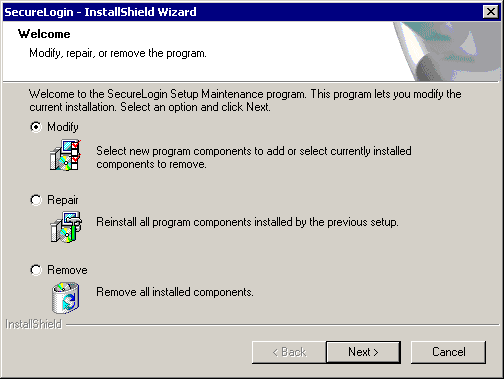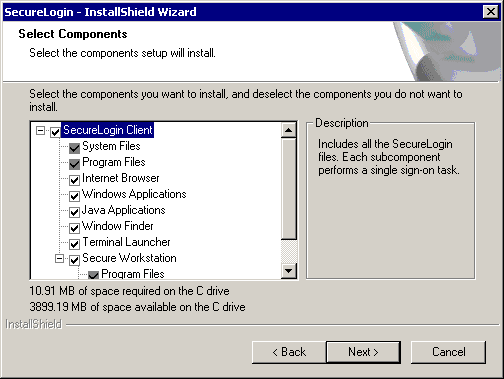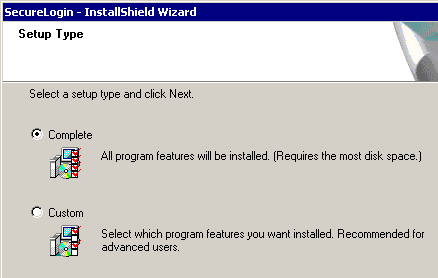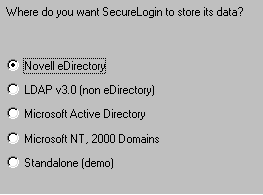Deploying SecureLogin
WARNING: The SecureLogin installation program overwrites the tlaunch.ini file. If you have enabled any terminal emulator applications for single sign-on, copy tlaunch.ini from the active directory (for example, Program Files\novell\securelogin) to a safe directory before upgrading or reinstalling SecureLogin. After upgrading or installing, copy the saved tlaunch.ini file back to the original file.
This section provides information on the following:
- Installing Java
If you want to enable Java applications for single sign-on, refer to this section. Otherwise, skip it.
- Using a Silent Install
- Automating the Installation
Installing Java
SecureLogin 3.51.2 supports Java applications. However, during installation the Java Applications component is displayed and available only if Java is installed on your workstation. If the Java Runtime Environment is not installed on your workstation, download and install it. To find out whether the Java Runtime Environment is installed on a workstation, use Add/Remove Programs in the Control Panel.
-
Go to the Java download Web page.
-
Click Free Download, then click Yes to install and run the Java plug-in.
-
Click Yes to install and run jinstallerx.exe.
-
Accept the license agreement, select a setup type, then click Next.
-
Click Finish, then restart your workstation.
Selecting Modify, Repair, or Remove
If you previously installed SecureLogin, InstallShield detects the installation and displays the following dialog box:

You can use the Modify operation to change components listed in the Select Components dialog box.

However, you can't change options that aren't listed. For example, you can't use Modify to change the platform.
Scenario: Changing a SecureLogin Platform. You previously installed the Standalone option to evaluate SecureLogin. After a successful evaluation, you install SecureLogin throughout the company, which is using eDirectory. Because you can't migrate from Standalone to eDirectory, you select Remove, uninstall SecureLogin, restart the workstation (if prompted), then reinstall.
To reinstall components, you select Repair. The installation program detects previously installed components and reinstalls them.
Using a Silent Install
A silent install provides InstallShield* with instructions for installing SecureLogin. To use a silent install, create and use a response file. The response file contains your responses to the dialog boxes that you encounter during the installation.
-
Run the installation in the same environment that the silent installation will run.
Do this before you create a response file. You need to be familiar with the installation process and options, so that you don't capture unnecessary data or missteps in the response file.
Also, the data in the response file depends on the workstation and options that you select to create the response file.
Scenario: Incompatible Workstations. You create the response file on a Windows 2000 workstation and then silently install on a Windows 98 workstation. The installation fails.
Scenario: Missing Software. You create a response file on a workstation that has the Novell Client. You then install silently on a workstation that doesn't have the Novell Client. The installation fails.
-
Set up a response file by typing
Setup.exe -r -f1"c:\setup.iss"
The -r parameter instructs InstallShield to record the installation.
The -f1 parameter specifies a filename and absolute path where the response file will be saved. If you omit this parameter, InstallShield saves the file to a default directory.
Although the double quotation marks aren't always required, they are required for long paths. You're safer by always including them.
No space exists between f1 and the first double quotation mark (f1"). Even if you choose not to use double quotation marks, don't place a space after f1.
The path must be absolute, rooted with a drive letter (for example, c). Don't use a relative path.
The default filename is setup.iss. However, you can specify any name, including the extension. Setup.iss is a text file.
-
(Optional) Set up a log file by adding the following parameters:
-f2"C:\setup.log"
The path to the log file is also absolute.
The complete entry, with the command, parameters for a response file, and parameters for a log file, appears as follows:
Setup.exe -s -f1"C:\setup.iss" -f2"C:\setup.log"
A silent install doesn't display the user interface. If problems arise, you need some mechanism to identify what isn't working as expected.
-
Run the installation.
InstallShield records all your responses to options in the dialog boxes.
-
Use the response file and log for silent installs.
A log file captures install information as result codes. If the result code is 0, the installation was successful. If other result codes appear, refer to the InstallShield documentation.
If you run setup.exe on a workstation that already has SecureLogin, the installation program goes to the Modify/Repair/Remove dialog box. Therefore, if you test the response file by running the silent install on the same workstation, uninstall SecureLogin first. Otherwise, the installation launches the maintenance dialog box and then writes an error code to the log file, indicating that the .iss file wasn't able to respond to the dialog boxes.
IMPORTANT: After a silent install, you have to reboot the system for SecureLogin to take effect. Otherwise, you might encounter the error message Unable to instantiate ScriptBroker module: 80040154.
Also, you can create silent Modify, Repair, and Remove response files.
Scenario: Using Silent Modify to Update Workstations. During a Phase 1 rollout, you silently installed SecureLogin on users' workstations, but didn't install the Secure Workstation component. Wanting users to have Secure Workstation functionality during the Phase 2 rollout, you create a response file by selecting Modify and the Secure Workstation component. You then update users' workstations by running silent installs with the new response file.
Automating the Installation
By editing the automate.ini file, you can automate parts of the installation and customize it before distributing SecureLogin to users or other installers.
-
Open automate.ini, found in the \securelogin\client directory.
-
Read the explanatory paragraphs so that you understand how to customize the installation.
-
Make changes.
The following figure illustrates the dialog box that enables you to pre-select a Complete or Custom installation.

The [SetupType] section in automate.ini determines whether the dialog box appears:
[SetupType]
;ShowDialog=No
;Selection=Complete
;Selection=CustomBy default, the dialog box displays. If you uncomment the ShowDialog line, the dialog box doesn't appear, and the installation program installs the Complete option by default.
The following figure illustrates the dialog box that enables users to select a platform:

The [Platform] section in automate.ini determines whether the dialog box appears:
[Platform]
;ShowDialog=No
;Selection=eDirectory
;Selection=LDAP
;Selection=ActiveDirectory
;Selection=NTDomain
;Selection=StandaloneBy default, the Choose a Platform dialog box displays. If you uncomment the ShowDialog and Selection=eDirectory lines, the dialog box doesn't appear. Instead, the installation program installs the eDirectory option by default.
-
Save and exit.